VARK Model of Learning: Explained with Four Learning Styles and Criticisms
VerifiedAdded on 2023/06/14
|8
|2007
|177
AI Summary
This essay explains the VARK Model of Learning and its four learning styles - visual, auditory, reading/writing, and kinesthetic. It also discusses the criticisms faced by this model, including its authenticity, restrictiveness, and lack of guidance for educators. The essay cites various studies and research to support its arguments.
Contribute Materials
Your contribution can guide someone’s learning journey. Share your
documents today.
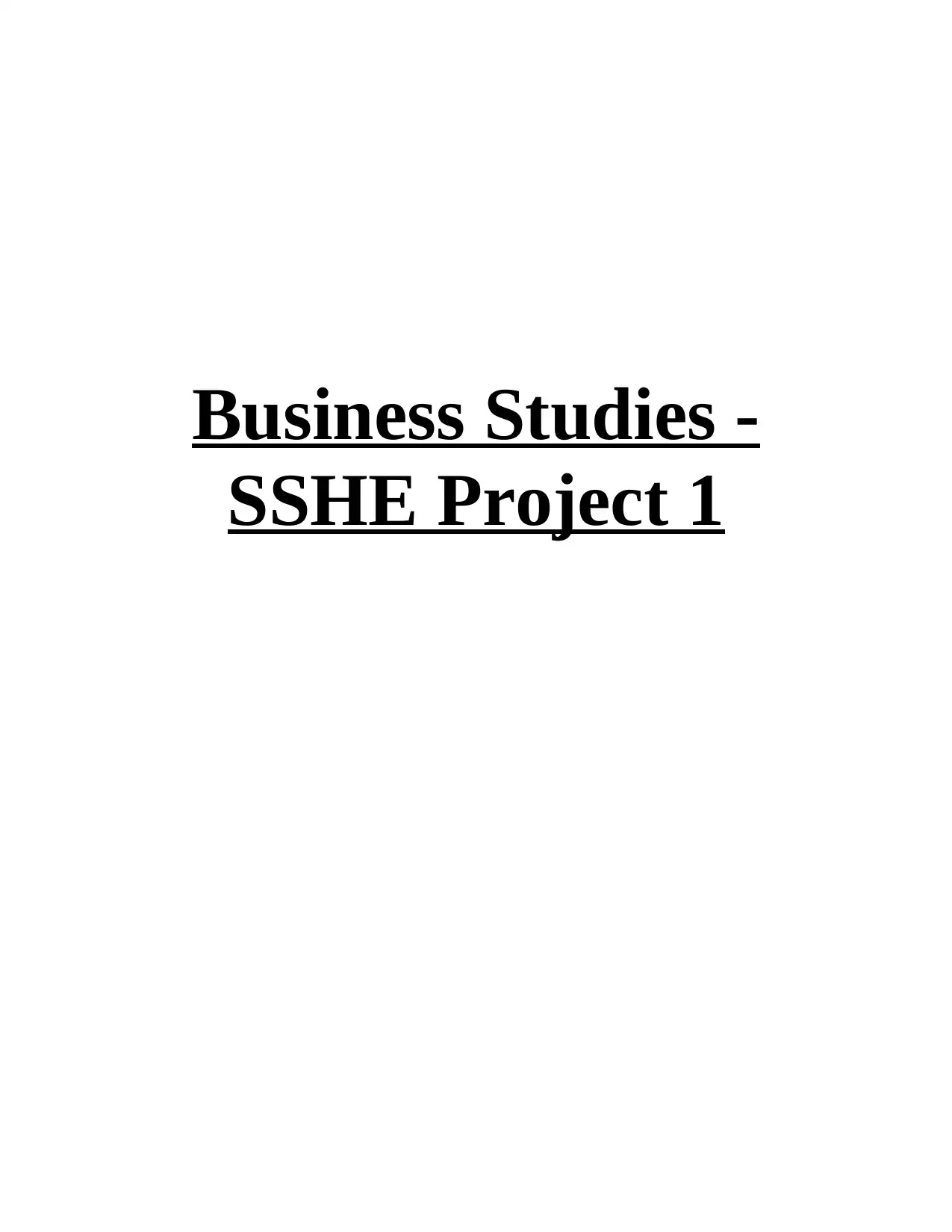
Business Studies -
SSHE Project 1
SSHE Project 1
Secure Best Marks with AI Grader
Need help grading? Try our AI Grader for instant feedback on your assignments.

Table of Contents
INTRODUCTION...........................................................................................................................1
MAIN BODY...................................................................................................................................1
CONCLUSION................................................................................................................................4
REFERENCES................................................................................................................................5
INTRODUCTION...........................................................................................................................1
MAIN BODY...................................................................................................................................1
CONCLUSION................................................................................................................................4
REFERENCES................................................................................................................................5
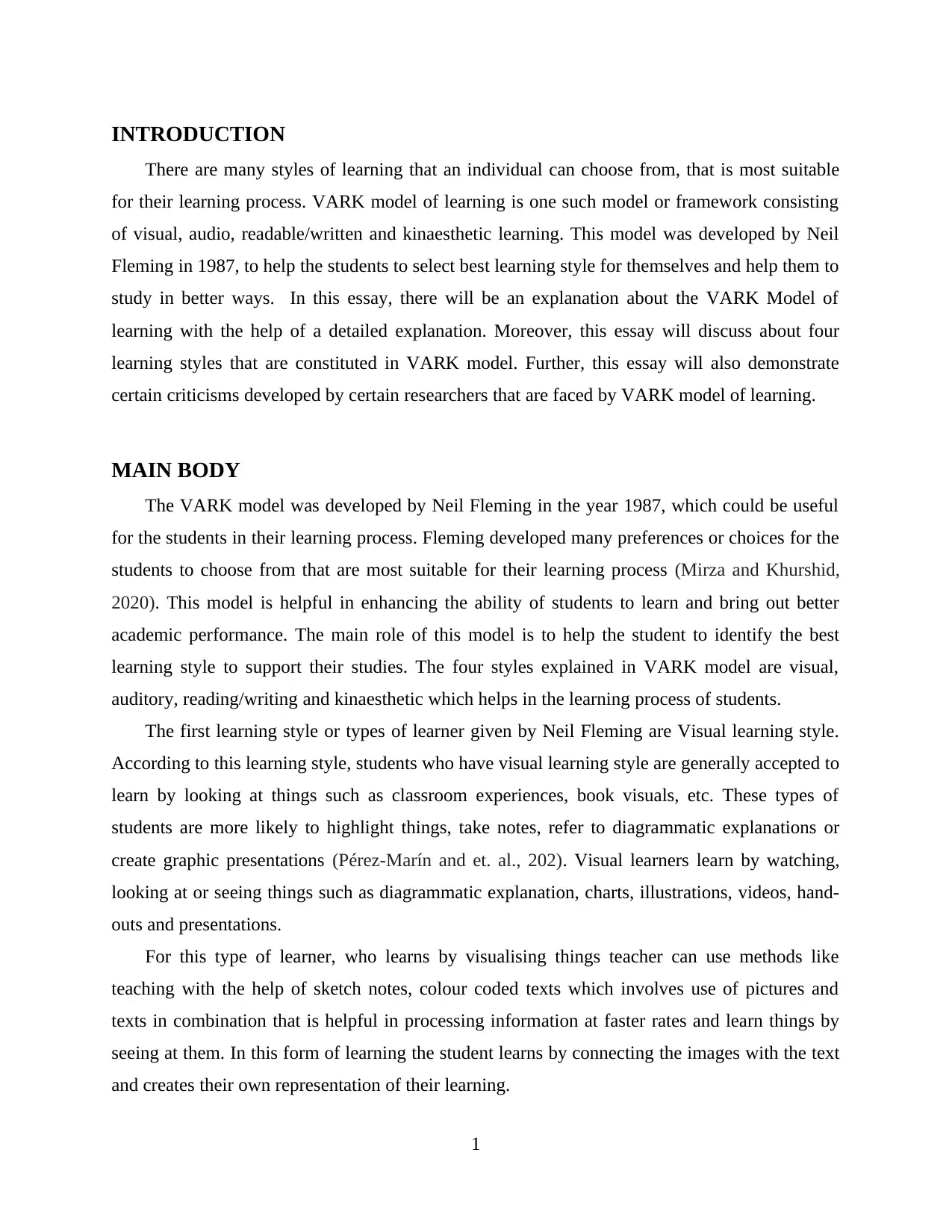
INTRODUCTION
There are many styles of learning that an individual can choose from, that is most suitable
for their learning process. VARK model of learning is one such model or framework consisting
of visual, audio, readable/written and kinaesthetic learning. This model was developed by Neil
Fleming in 1987, to help the students to select best learning style for themselves and help them to
study in better ways. In this essay, there will be an explanation about the VARK Model of
learning with the help of a detailed explanation. Moreover, this essay will discuss about four
learning styles that are constituted in VARK model. Further, this essay will also demonstrate
certain criticisms developed by certain researchers that are faced by VARK model of learning.
MAIN BODY
The VARK model was developed by Neil Fleming in the year 1987, which could be useful
for the students in their learning process. Fleming developed many preferences or choices for the
students to choose from that are most suitable for their learning process (Mirza and Khurshid,
2020). This model is helpful in enhancing the ability of students to learn and bring out better
academic performance. The main role of this model is to help the student to identify the best
learning style to support their studies. The four styles explained in VARK model are visual,
auditory, reading/writing and kinaesthetic which helps in the learning process of students.
The first learning style or types of learner given by Neil Fleming are Visual learning style.
According to this learning style, students who have visual learning style are generally accepted to
learn by looking at things such as classroom experiences, book visuals, etc. These types of
students are more likely to highlight things, take notes, refer to diagrammatic explanations or
create graphic presentations (Pérez-Marín and et. al., 202). Visual learners learn by watching,
looking at or seeing things such as diagrammatic explanation, charts, illustrations, videos, hand-
outs and presentations.
For this type of learner, who learns by visualising things teacher can use methods like
teaching with the help of sketch notes, colour coded texts which involves use of pictures and
texts in combination that is helpful in processing information at faster rates and learn things by
seeing at them. In this form of learning the student learns by connecting the images with the text
and creates their own representation of their learning.
1
There are many styles of learning that an individual can choose from, that is most suitable
for their learning process. VARK model of learning is one such model or framework consisting
of visual, audio, readable/written and kinaesthetic learning. This model was developed by Neil
Fleming in 1987, to help the students to select best learning style for themselves and help them to
study in better ways. In this essay, there will be an explanation about the VARK Model of
learning with the help of a detailed explanation. Moreover, this essay will discuss about four
learning styles that are constituted in VARK model. Further, this essay will also demonstrate
certain criticisms developed by certain researchers that are faced by VARK model of learning.
MAIN BODY
The VARK model was developed by Neil Fleming in the year 1987, which could be useful
for the students in their learning process. Fleming developed many preferences or choices for the
students to choose from that are most suitable for their learning process (Mirza and Khurshid,
2020). This model is helpful in enhancing the ability of students to learn and bring out better
academic performance. The main role of this model is to help the student to identify the best
learning style to support their studies. The four styles explained in VARK model are visual,
auditory, reading/writing and kinaesthetic which helps in the learning process of students.
The first learning style or types of learner given by Neil Fleming are Visual learning style.
According to this learning style, students who have visual learning style are generally accepted to
learn by looking at things such as classroom experiences, book visuals, etc. These types of
students are more likely to highlight things, take notes, refer to diagrammatic explanations or
create graphic presentations (Pérez-Marín and et. al., 202). Visual learners learn by watching,
looking at or seeing things such as diagrammatic explanation, charts, illustrations, videos, hand-
outs and presentations.
For this type of learner, who learns by visualising things teacher can use methods like
teaching with the help of sketch notes, colour coded texts which involves use of pictures and
texts in combination that is helpful in processing information at faster rates and learn things by
seeing at them. In this form of learning the student learns by connecting the images with the text
and creates their own representation of their learning.
1
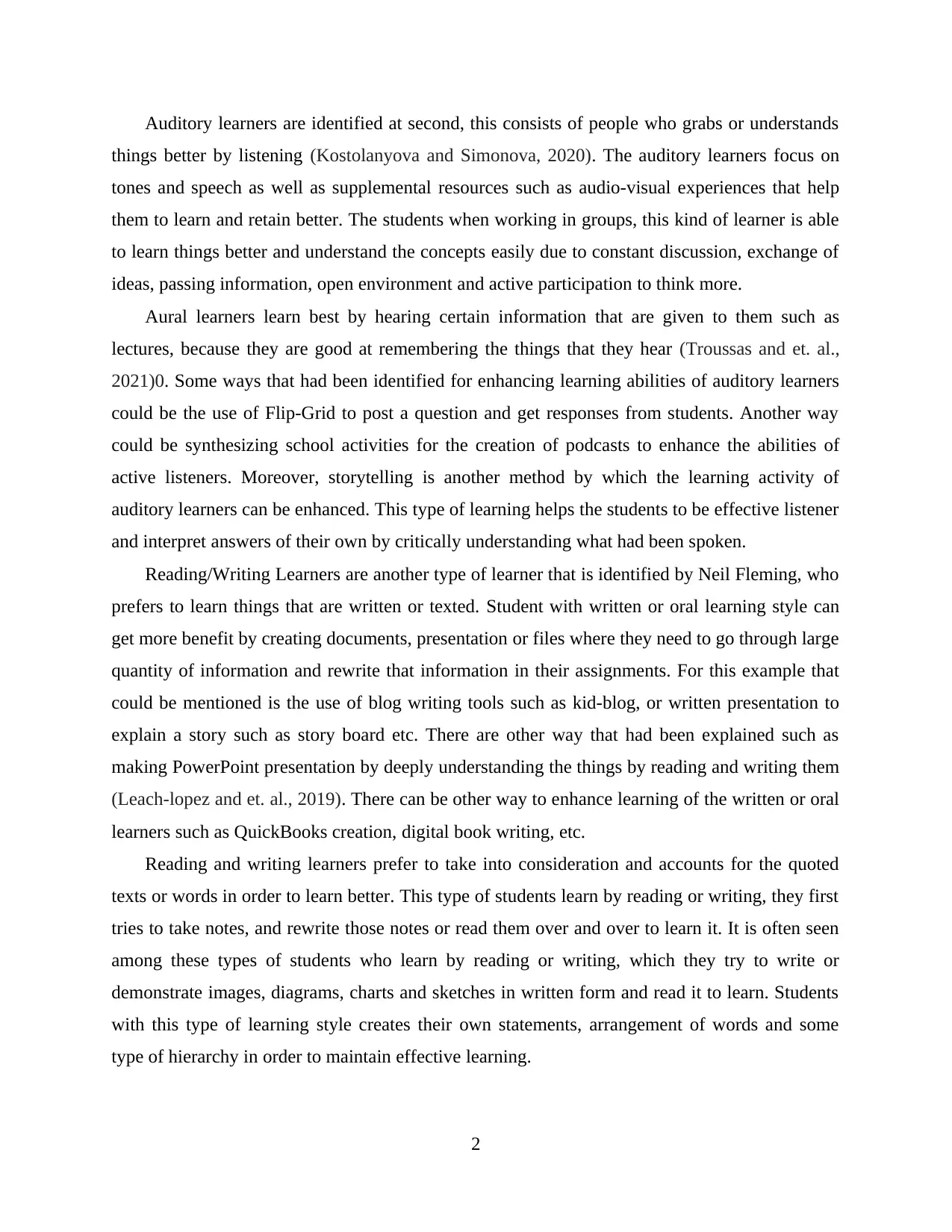
Auditory learners are identified at second, this consists of people who grabs or understands
things better by listening (Kostolanyova and Simonova, 2020). The auditory learners focus on
tones and speech as well as supplemental resources such as audio-visual experiences that help
them to learn and retain better. The students when working in groups, this kind of learner is able
to learn things better and understand the concepts easily due to constant discussion, exchange of
ideas, passing information, open environment and active participation to think more.
Aural learners learn best by hearing certain information that are given to them such as
lectures, because they are good at remembering the things that they hear (Troussas and et. al.,
2021)0. Some ways that had been identified for enhancing learning abilities of auditory learners
could be the use of Flip-Grid to post a question and get responses from students. Another way
could be synthesizing school activities for the creation of podcasts to enhance the abilities of
active listeners. Moreover, storytelling is another method by which the learning activity of
auditory learners can be enhanced. This type of learning helps the students to be effective listener
and interpret answers of their own by critically understanding what had been spoken.
Reading/Writing Learners are another type of learner that is identified by Neil Fleming, who
prefers to learn things that are written or texted. Student with written or oral learning style can
get more benefit by creating documents, presentation or files where they need to go through large
quantity of information and rewrite that information in their assignments. For this example that
could be mentioned is the use of blog writing tools such as kid-blog, or written presentation to
explain a story such as story board etc. There are other way that had been explained such as
making PowerPoint presentation by deeply understanding the things by reading and writing them
(Leach-lopez and et. al., 2019). There can be other way to enhance learning of the written or oral
learners such as QuickBooks creation, digital book writing, etc.
Reading and writing learners prefer to take into consideration and accounts for the quoted
texts or words in order to learn better. This type of students learn by reading or writing, they first
tries to take notes, and rewrite those notes or read them over and over to learn it. It is often seen
among these types of students who learn by reading or writing, which they try to write or
demonstrate images, diagrams, charts and sketches in written form and read it to learn. Students
with this type of learning style creates their own statements, arrangement of words and some
type of hierarchy in order to maintain effective learning.
2
things better by listening (Kostolanyova and Simonova, 2020). The auditory learners focus on
tones and speech as well as supplemental resources such as audio-visual experiences that help
them to learn and retain better. The students when working in groups, this kind of learner is able
to learn things better and understand the concepts easily due to constant discussion, exchange of
ideas, passing information, open environment and active participation to think more.
Aural learners learn best by hearing certain information that are given to them such as
lectures, because they are good at remembering the things that they hear (Troussas and et. al.,
2021)0. Some ways that had been identified for enhancing learning abilities of auditory learners
could be the use of Flip-Grid to post a question and get responses from students. Another way
could be synthesizing school activities for the creation of podcasts to enhance the abilities of
active listeners. Moreover, storytelling is another method by which the learning activity of
auditory learners can be enhanced. This type of learning helps the students to be effective listener
and interpret answers of their own by critically understanding what had been spoken.
Reading/Writing Learners are another type of learner that is identified by Neil Fleming, who
prefers to learn things that are written or texted. Student with written or oral learning style can
get more benefit by creating documents, presentation or files where they need to go through large
quantity of information and rewrite that information in their assignments. For this example that
could be mentioned is the use of blog writing tools such as kid-blog, or written presentation to
explain a story such as story board etc. There are other way that had been explained such as
making PowerPoint presentation by deeply understanding the things by reading and writing them
(Leach-lopez and et. al., 2019). There can be other way to enhance learning of the written or oral
learners such as QuickBooks creation, digital book writing, etc.
Reading and writing learners prefer to take into consideration and accounts for the quoted
texts or words in order to learn better. This type of students learn by reading or writing, they first
tries to take notes, and rewrite those notes or read them over and over to learn it. It is often seen
among these types of students who learn by reading or writing, which they try to write or
demonstrate images, diagrams, charts and sketches in written form and read it to learn. Students
with this type of learning style creates their own statements, arrangement of words and some
type of hierarchy in order to maintain effective learning.
2
Secure Best Marks with AI Grader
Need help grading? Try our AI Grader for instant feedback on your assignments.
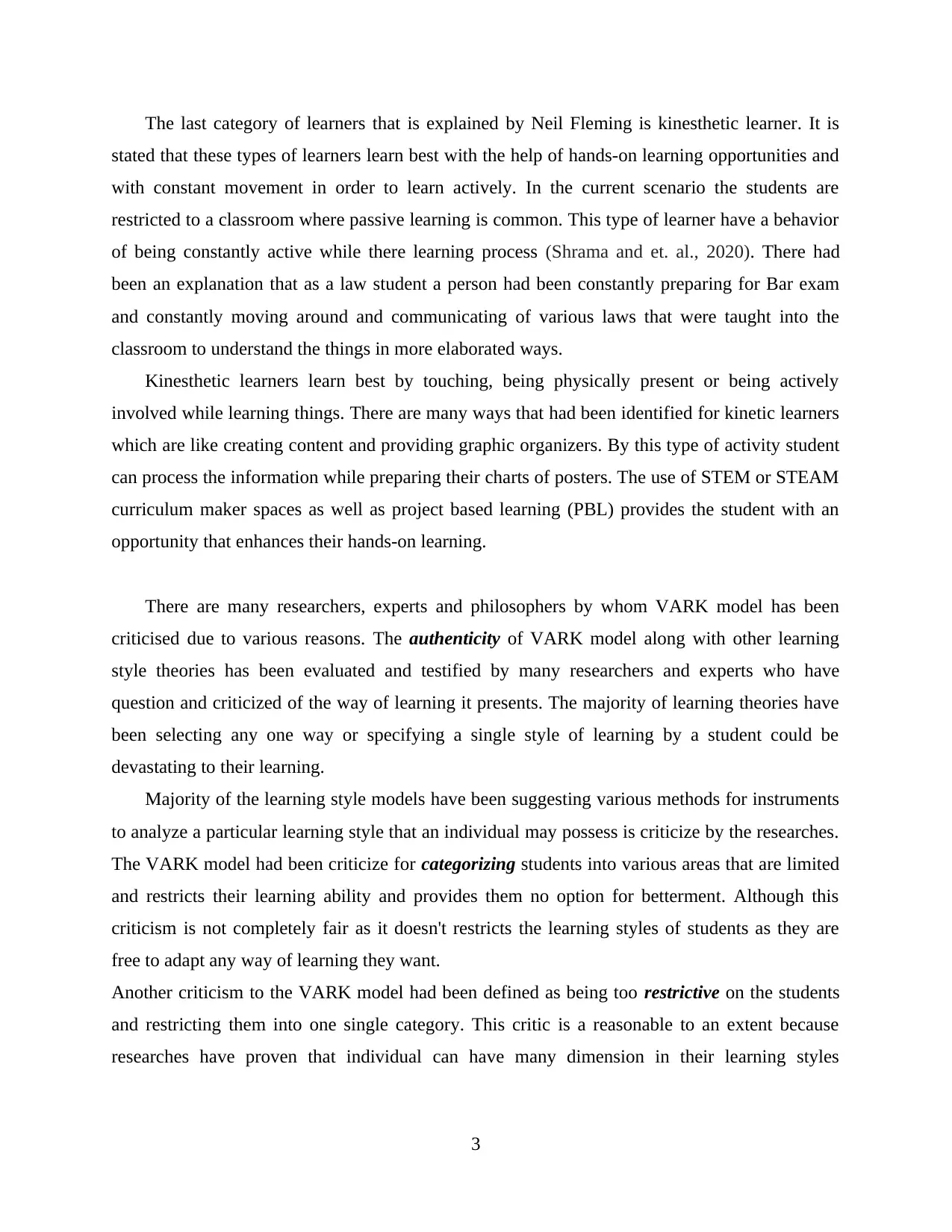
The last category of learners that is explained by Neil Fleming is kinesthetic learner. It is
stated that these types of learners learn best with the help of hands-on learning opportunities and
with constant movement in order to learn actively. In the current scenario the students are
restricted to a classroom where passive learning is common. This type of learner have a behavior
of being constantly active while there learning process (Shrama and et. al., 2020). There had
been an explanation that as a law student a person had been constantly preparing for Bar exam
and constantly moving around and communicating of various laws that were taught into the
classroom to understand the things in more elaborated ways.
Kinesthetic learners learn best by touching, being physically present or being actively
involved while learning things. There are many ways that had been identified for kinetic learners
which are like creating content and providing graphic organizers. By this type of activity student
can process the information while preparing their charts of posters. The use of STEM or STEAM
curriculum maker spaces as well as project based learning (PBL) provides the student with an
opportunity that enhances their hands-on learning.
There are many researchers, experts and philosophers by whom VARK model has been
criticised due to various reasons. The authenticity of VARK model along with other learning
style theories has been evaluated and testified by many researchers and experts who have
question and criticized of the way of learning it presents. The majority of learning theories have
been selecting any one way or specifying a single style of learning by a student could be
devastating to their learning.
Majority of the learning style models have been suggesting various methods for instruments
to analyze a particular learning style that an individual may possess is criticize by the researches.
The VARK model had been criticize for categorizing students into various areas that are limited
and restricts their learning ability and provides them no option for betterment. Although this
criticism is not completely fair as it doesn't restricts the learning styles of students as they are
free to adapt any way of learning they want.
Another criticism to the VARK model had been defined as being too restrictive on the students
and restricting them into one single category. This critic is a reasonable to an extent because
researches have proven that individual can have many dimension in their learning styles
3
stated that these types of learners learn best with the help of hands-on learning opportunities and
with constant movement in order to learn actively. In the current scenario the students are
restricted to a classroom where passive learning is common. This type of learner have a behavior
of being constantly active while there learning process (Shrama and et. al., 2020). There had
been an explanation that as a law student a person had been constantly preparing for Bar exam
and constantly moving around and communicating of various laws that were taught into the
classroom to understand the things in more elaborated ways.
Kinesthetic learners learn best by touching, being physically present or being actively
involved while learning things. There are many ways that had been identified for kinetic learners
which are like creating content and providing graphic organizers. By this type of activity student
can process the information while preparing their charts of posters. The use of STEM or STEAM
curriculum maker spaces as well as project based learning (PBL) provides the student with an
opportunity that enhances their hands-on learning.
There are many researchers, experts and philosophers by whom VARK model has been
criticised due to various reasons. The authenticity of VARK model along with other learning
style theories has been evaluated and testified by many researchers and experts who have
question and criticized of the way of learning it presents. The majority of learning theories have
been selecting any one way or specifying a single style of learning by a student could be
devastating to their learning.
Majority of the learning style models have been suggesting various methods for instruments
to analyze a particular learning style that an individual may possess is criticize by the researches.
The VARK model had been criticize for categorizing students into various areas that are limited
and restricts their learning ability and provides them no option for betterment. Although this
criticism is not completely fair as it doesn't restricts the learning styles of students as they are
free to adapt any way of learning they want.
Another criticism to the VARK model had been defined as being too restrictive on the students
and restricting them into one single category. This critic is a reasonable to an extent because
researches have proven that individual can have many dimension in their learning styles
3
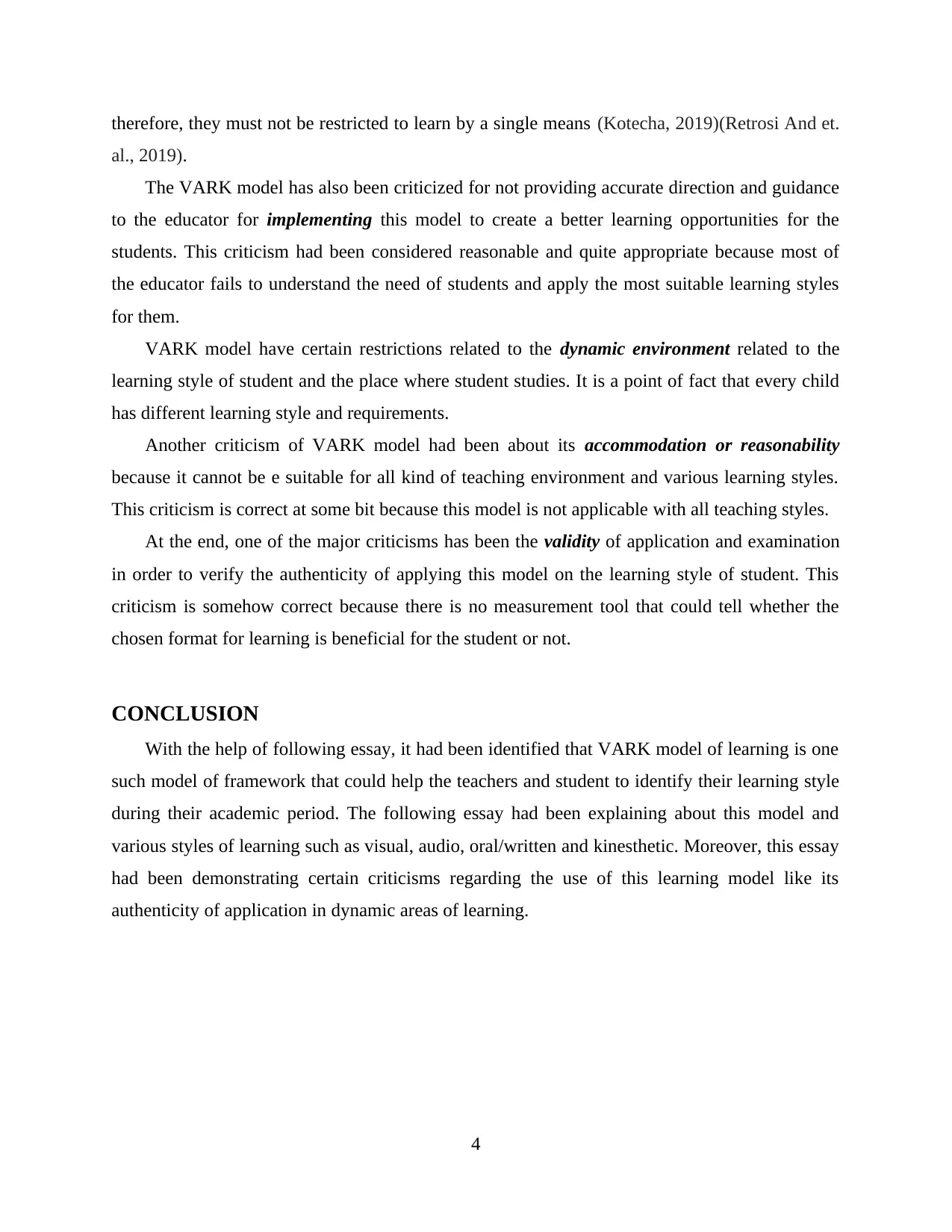
therefore, they must not be restricted to learn by a single means (Kotecha, 2019)(Retrosi And et.
al., 2019).
The VARK model has also been criticized for not providing accurate direction and guidance
to the educator for implementing this model to create a better learning opportunities for the
students. This criticism had been considered reasonable and quite appropriate because most of
the educator fails to understand the need of students and apply the most suitable learning styles
for them.
VARK model have certain restrictions related to the dynamic environment related to the
learning style of student and the place where student studies. It is a point of fact that every child
has different learning style and requirements.
Another criticism of VARK model had been about its accommodation or reasonability
because it cannot be e suitable for all kind of teaching environment and various learning styles.
This criticism is correct at some bit because this model is not applicable with all teaching styles.
At the end, one of the major criticisms has been the validity of application and examination
in order to verify the authenticity of applying this model on the learning style of student. This
criticism is somehow correct because there is no measurement tool that could tell whether the
chosen format for learning is beneficial for the student or not.
CONCLUSION
With the help of following essay, it had been identified that VARK model of learning is one
such model of framework that could help the teachers and student to identify their learning style
during their academic period. The following essay had been explaining about this model and
various styles of learning such as visual, audio, oral/written and kinesthetic. Moreover, this essay
had been demonstrating certain criticisms regarding the use of this learning model like its
authenticity of application in dynamic areas of learning.
4
al., 2019).
The VARK model has also been criticized for not providing accurate direction and guidance
to the educator for implementing this model to create a better learning opportunities for the
students. This criticism had been considered reasonable and quite appropriate because most of
the educator fails to understand the need of students and apply the most suitable learning styles
for them.
VARK model have certain restrictions related to the dynamic environment related to the
learning style of student and the place where student studies. It is a point of fact that every child
has different learning style and requirements.
Another criticism of VARK model had been about its accommodation or reasonability
because it cannot be e suitable for all kind of teaching environment and various learning styles.
This criticism is correct at some bit because this model is not applicable with all teaching styles.
At the end, one of the major criticisms has been the validity of application and examination
in order to verify the authenticity of applying this model on the learning style of student. This
criticism is somehow correct because there is no measurement tool that could tell whether the
chosen format for learning is beneficial for the student or not.
CONCLUSION
With the help of following essay, it had been identified that VARK model of learning is one
such model of framework that could help the teachers and student to identify their learning style
during their academic period. The following essay had been explaining about this model and
various styles of learning such as visual, audio, oral/written and kinesthetic. Moreover, this essay
had been demonstrating certain criticisms regarding the use of this learning model like its
authenticity of application in dynamic areas of learning.
4
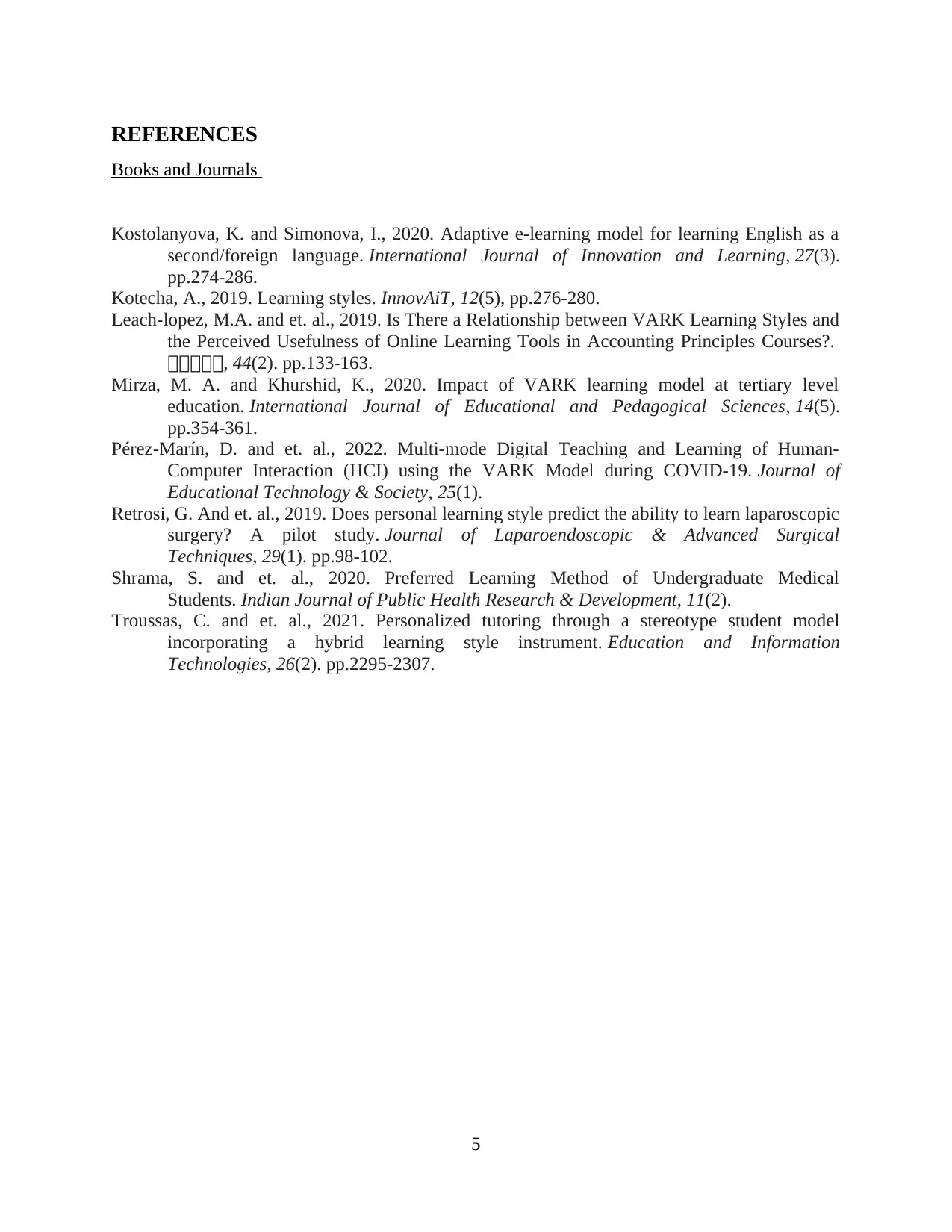
REFERENCES
Books and Journals
Kostolanyova, K. and Simonova, I., 2020. Adaptive e-learning model for learning English as a
second/foreign language. International Journal of Innovation and Learning, 27(3).
pp.274-286.
Kotecha, A., 2019. Learning styles. InnovAiT, 12(5), pp.276-280.
Leach-lopez, M.A. and et. al., 2019. Is There a Relationship between VARK Learning Styles and
the Perceived Usefulness of Online Learning Tools in Accounting Principles Courses?.
회회회회회, 44(2). pp.133-163.
Mirza, M. A. and Khurshid, K., 2020. Impact of VARK learning model at tertiary level
education. International Journal of Educational and Pedagogical Sciences, 14(5).
pp.354-361.
Pérez-Marín, D. and et. al., 2022. Multi-mode Digital Teaching and Learning of Human-
Computer Interaction (HCI) using the VARK Model during COVID-19. Journal of
Educational Technology & Society, 25(1).
Retrosi, G. And et. al., 2019. Does personal learning style predict the ability to learn laparoscopic
surgery? A pilot study. Journal of Laparoendoscopic & Advanced Surgical
Techniques, 29(1). pp.98-102.
Shrama, S. and et. al., 2020. Preferred Learning Method of Undergraduate Medical
Students. Indian Journal of Public Health Research & Development, 11(2).
Troussas, C. and et. al., 2021. Personalized tutoring through a stereotype student model
incorporating a hybrid learning style instrument. Education and Information
Technologies, 26(2). pp.2295-2307.
5
Books and Journals
Kostolanyova, K. and Simonova, I., 2020. Adaptive e-learning model for learning English as a
second/foreign language. International Journal of Innovation and Learning, 27(3).
pp.274-286.
Kotecha, A., 2019. Learning styles. InnovAiT, 12(5), pp.276-280.
Leach-lopez, M.A. and et. al., 2019. Is There a Relationship between VARK Learning Styles and
the Perceived Usefulness of Online Learning Tools in Accounting Principles Courses?.
회회회회회, 44(2). pp.133-163.
Mirza, M. A. and Khurshid, K., 2020. Impact of VARK learning model at tertiary level
education. International Journal of Educational and Pedagogical Sciences, 14(5).
pp.354-361.
Pérez-Marín, D. and et. al., 2022. Multi-mode Digital Teaching and Learning of Human-
Computer Interaction (HCI) using the VARK Model during COVID-19. Journal of
Educational Technology & Society, 25(1).
Retrosi, G. And et. al., 2019. Does personal learning style predict the ability to learn laparoscopic
surgery? A pilot study. Journal of Laparoendoscopic & Advanced Surgical
Techniques, 29(1). pp.98-102.
Shrama, S. and et. al., 2020. Preferred Learning Method of Undergraduate Medical
Students. Indian Journal of Public Health Research & Development, 11(2).
Troussas, C. and et. al., 2021. Personalized tutoring through a stereotype student model
incorporating a hybrid learning style instrument. Education and Information
Technologies, 26(2). pp.2295-2307.
5
Paraphrase This Document
Need a fresh take? Get an instant paraphrase of this document with our AI Paraphraser

6
1 out of 8
Your All-in-One AI-Powered Toolkit for Academic Success.
+13062052269
info@desklib.com
Available 24*7 on WhatsApp / Email
![[object Object]](/_next/static/media/star-bottom.7253800d.svg)
Unlock your academic potential
© 2024 | Zucol Services PVT LTD | All rights reserved.


